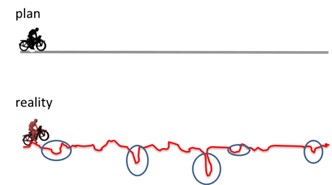Jun13

How good are our company plans? What kind of assumptions do we make and what happens when they meet reality?
The reference points for every budget year are:
· Assumptions derived from past performance
· Assumptions about things that may impact our company performance in the coming year
· Assumptions about costs
· Assumptions about revenue
· Assumptions about profit
· Assumptions about passenger numbers
· Assumptions about….
Too many assumptions lead to too many disruptions.
We tend to make company plans look smoother and prettier, with the desire to do things better. And then comes the time when these assumptions undergo the test of reality. This is when misfits become visible, leading to a bumpier road ahead and less control over the outcomes expressed through cost, profit, and other performance metrics.
The majority of airlines miss this unique opportunity for learning. The paths of lean airlines with simpler business models are less bumpy. They have easier access to reality, enabling them to learn what works for them and what doesn't.
Traditional airlines, however, are heavier, trapped in once successful but now hard-to-control business models accompanied by rising complexities. This makes them more susceptible to unexpected losses caused by even the smallest challenges.
Can we reduce the number of assumptions and flatten the road ahead?
Yes, we can if we embrace the practice of validated learning and:
· Start thinking afresh
· Become open to learning on the go
· Start testing assumptions in an organised way, focusing on the biggest deviations from the flat lines
Validated learning is an invaluable technique, especially in the age of uncertainty. Instead of bouncing back, we can consider bouncing forward.
This is how improvement happens.
Keywords: Business Strategy, Innovation, Management
 Autonomous Wingmen: Scaling Sustainable Aviation via NVIDIA NAT and Formation Flight
Autonomous Wingmen: Scaling Sustainable Aviation via NVIDIA NAT and Formation Flight The Board Chair as the Primary Lever of Psychological Safety
The Board Chair as the Primary Lever of Psychological Safety Friday’s Change Reflection Quote - Leadership of Change - Change Leaders Maintain Trust and Legitimacy
Friday’s Change Reflection Quote - Leadership of Change - Change Leaders Maintain Trust and Legitimacy The Corix Partners Friday Reading List - January 16, 2026
The Corix Partners Friday Reading List - January 16, 2026 Effective Government Is Built: A Five-Pillar Framework for Public Leaders
Effective Government Is Built: A Five-Pillar Framework for Public Leaders